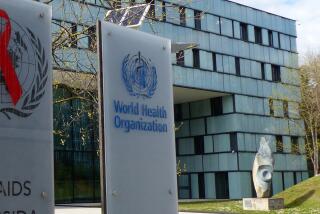Fuming over formaldehyde
- Share via
The Centers for Disease Control and Prevention failed to act for at least a year on warnings that trailers housing refugees from Hurricanes Katrina and Rita contained dangerous levels of formaldehyde, according to a House subcommittee report released Monday.
Instead, the CDC’s Agency for Toxic Substances and Disease Registry demoted the scientist who questioned its initial assessment that the trailers were safe as long as residents opened a window or another vent, the report said.
That appraisal was produced in February 2007 at the request of the Federal Emergency Management Agency, which had received thousands of complaints about fumes since providing the trailers to families left homeless by the devastating 2005 hurricanes. One year later, FEMA and CDC reversed course and acknowledged that formaldehyde levels in the trailers were five times higher than are typically found in new housing.
Formaldehyde is known to cause cancer, chronic bronchitis, eye irritation and other ailments. It was used in glue for rugs, plywood, fiberboard and other materials.
“FEMA was more concerned about legal liability than they were about people living in the trailers,” said Rep. Brad Miller (D-N.C.), chairman of the House Science and Technology Committee’s Investigation and Oversight Subcommittee. “It certainly appears that [the agency] was more interested in giving FEMA what FEMA wanted, amazingly, than it was in its mission of protecting the public.”
The subcommittee’s report came three days after a federal judge in New Orleans ruled that FEMA can be sued by hurricane victims who claim they were exposed to toxic fumes.
The CDC issued a statement Monday saying that the subcommittee report focused on the February 2007 assessment and not an October revision or other CDC efforts to address formaldehyde exposure.
“CDC also shares the desire of advocates and congressional investigators to ensure the best public health processes and science are used to understand the health effects associated with exposure to formaldehyde,” the statement said.
The subcommittee report noted that the agency took eight months to revise its initial finding and did so only after Christopher De Rosa, then director of the CDC agency’s Division of Toxicology and Environmental Medicine, publicly flagged scientific errors.
“We believe that Dr. De Rosa is a whistle-blower and was removed from his position, which he had held for 16 years, in retaliation for his persistent attempts to push the agency’s leadership to take more substantive actions to protect the public’s health,” the report said.
CDC acknowledged in February of this year that a third of the trailers it tested had formaldehyde levels high enough to harm children, the elderly and adults with respiratory problems, prompting FEMA to accelerate its efforts to relocate the 38,297 families then still in trailers and mobile homes. Fewer than 9,000 remained last month, according to the FEMA website.
The report documented in meticulous detail what the CDC agency knew about the formaldehyde problem, and when.
At congressional hearings six months ago, for example, agency Director Dr. Howard Frumkin and Deputy Director Thomas Sinks testified that they didn’t focus on questions about the CDC’s formaldehyde assessment until July 2007, when Rep. Henry A. Waxman (D-Beverly Hills) held the first hearing on the issue. But an examination of agency agendas revealed that the issue was discussed during at least 13 meetings prior to those hearings, the report said.
At the hearings, Frumkin and Sinks blamed De Rosa for failing to catch the errors in the initial assessment. Yet the report concluded that Frumkin, Sinks and three others reviewed the assessment, not De Rosa.
The agency’s “reaction was marred by scientific flaws, ineffective leadership, a sluggish response to inform trailer residents of the potential risks they faced and a lack of urgency to actually move them from harm’s way,” the report said.
--
More to Read
Sign up for Essential California
The most important California stories and recommendations in your inbox every morning.
You may occasionally receive promotional content from the Los Angeles Times.










